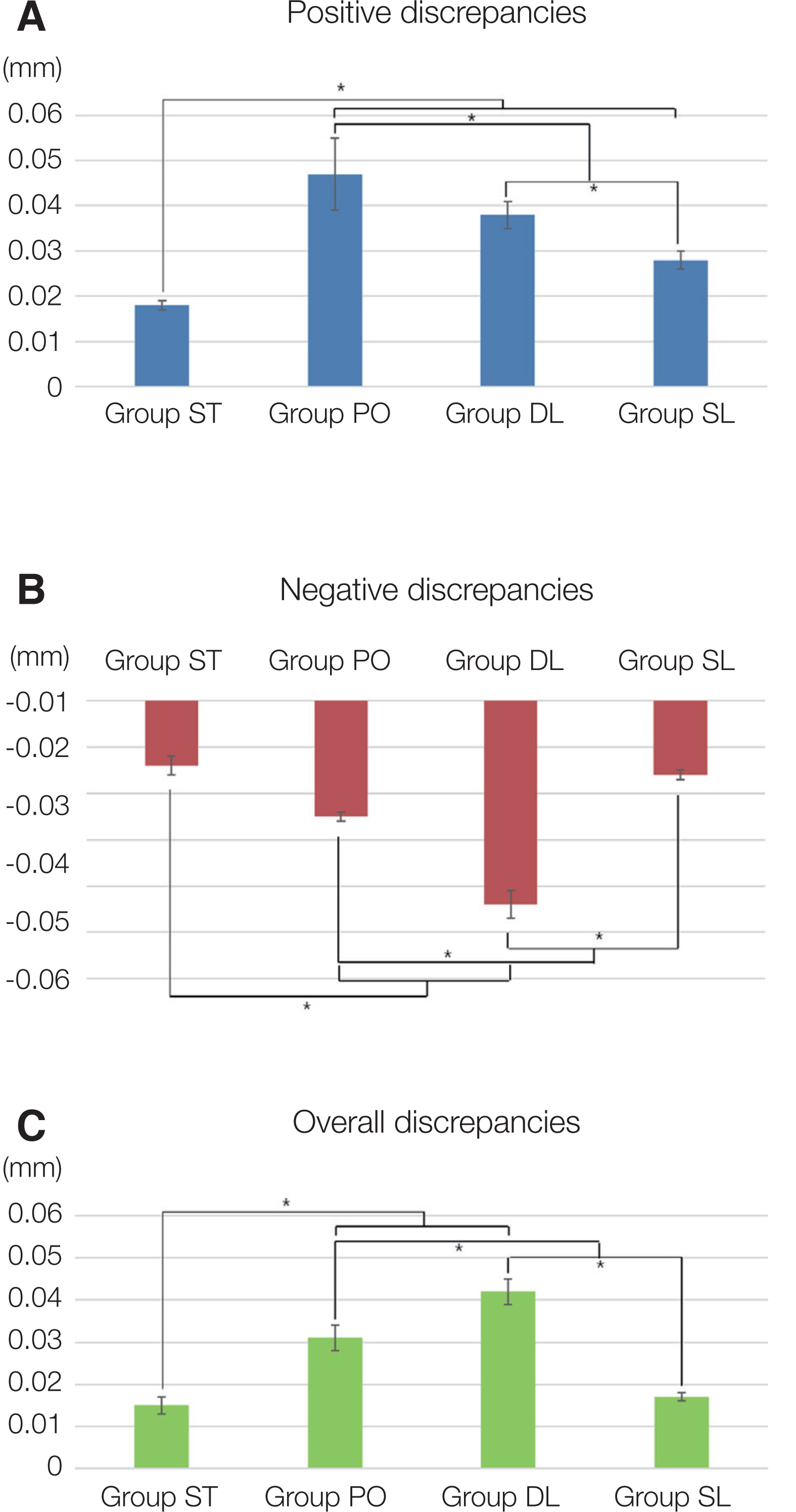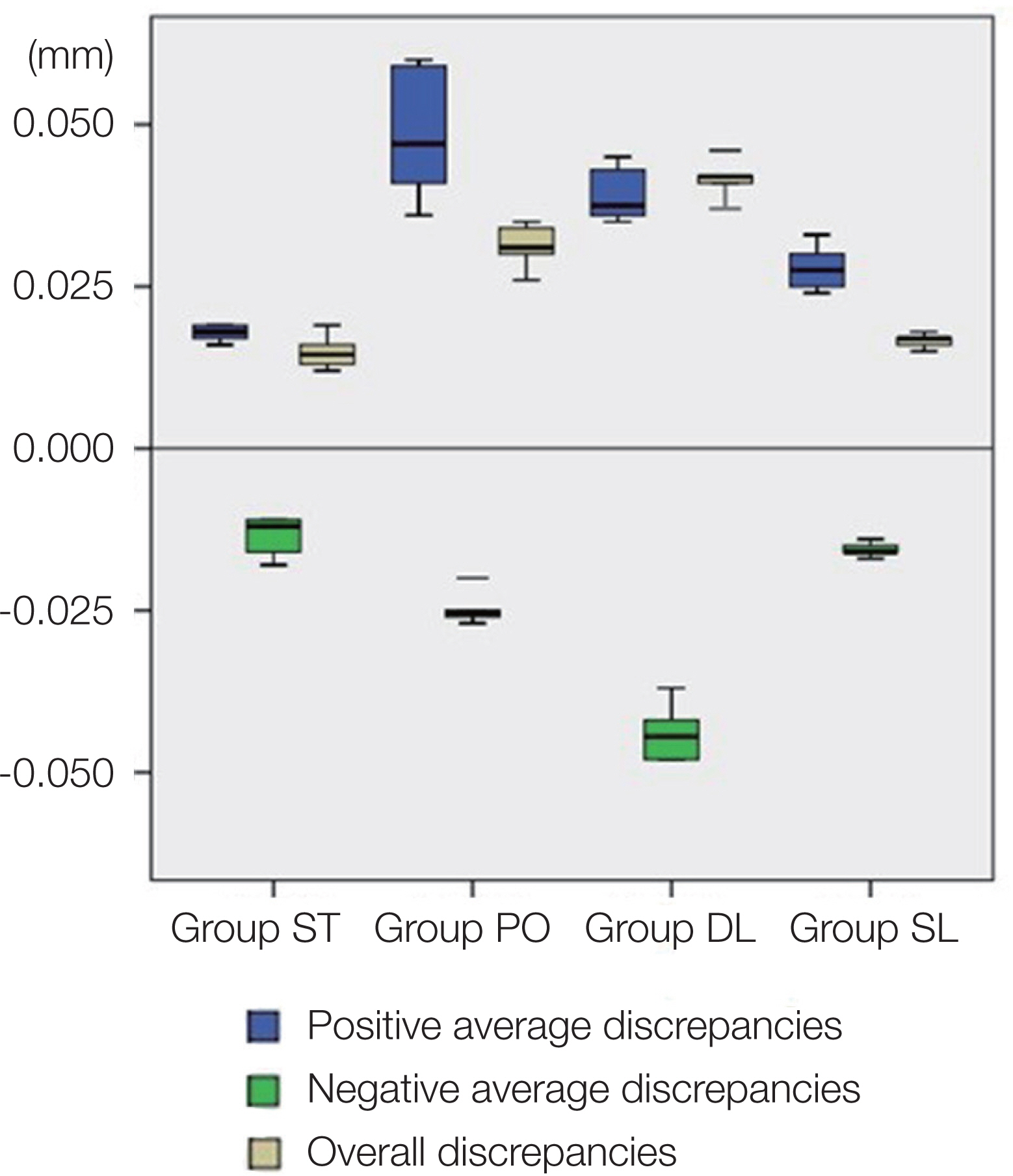J Dent Rehabil Appl Sci.
2020 Dec;36(4):242-253. 10.14368/jdras.2020.36.4.242.
Accuracy of dies fabricated by various three dimensional printing systems: a comparative study
- Affiliations
-
- 1Dental Clinic Center, ChungBuk National University Hosptial, Cheongju, Republic of Korea
- 2Department of Prosthodontics, College of Dentistry, Dankook University, Cheonan, Republic of Korea
- KMID: 2512119
- DOI: http://doi.org/10.14368/jdras.2020.36.4.242
Abstract
- Purpose
The aim of this study was to compare the accuracy of dies fabricated using 3D printing system to conventional method and to evaluate overall volumetric changes by arranging the superimposed surfaces.
Materials and Methods
A mandibular right first molar from a dental model was prepared, scanned and fabricated with composites of polyetherketoneketone (PEKK). Master dies were classified into 4 groups. For the conventional method, the impression was taken with polyvinylsiloxane and the impression was poured with Type IV dental stone. For the 3D printing, the standard die was scanned and converted into models using three different 3D printers. Each of four methods was used to make 10 specimens. Scanned files were superimposed with the standard die by using 3D surface matching software. For statistical analysis, Kruskal-Wallis test and Mann-Whitney U test were done (P < 0.05).
Results
Compared to the standard model, the volumetric changes of dies fabricated by each method were significantly different except the models fabricated by conventional method and 3D printer of Stereolithography (P < 0.05). The conventional dies showed the lowest volumetric change than 3D printed dies (P < 0.05). 3D printed dies fabricated by Stereolithography showed the lowest volumetric change among the different 3D printers (P < 0.05).
Conclusion
The conventional dies were more accurate than 3D printed dies, though 3D printed dies were within clinically acceptable range. Thus, 3D printed dies can be used for fabricating restorations.
Keyword
Figure
Reference
-
References
1. Stansbury JW, Idacavage MJ. 2016; 3D printing with polymers: Challenges among expanding options and opportunities. Dent Mater. 32:54–64. DOI: 10.1016/j.dental.2015.09.018. PMID: 26494268.2. Sun J, Zhang FQ. 2012; The application of rapid prototyping in prosthodontics. J Prosthodont. 21:641–4. DOI: 10.1111/j.1532-849X.2012.00888.x. PMID: 22823471.3. van Noort R. 2012; The future of dental devices is digital. Dent Mater. 28:3–12. DOI: 10.1016/j.dental.2011.10.014. PMID: 22119539.4. Ian G, David R, Brent S. 2015. Additive manufacturing technologies: 3d printing, rapid prototyping, and direct digital manufacturing. 2nd ed. Springer;New York:5. Faber J, Berto PM, Quaresma M. 2006; Rapid prototyping as a tool for diagnosis and treatment planning for maxillary canine impaction. Am J Orthod Dentofacial Orthop. 129:583–9. DOI: 10.1016/j.ajodo.2005.12.015. PMID: 16627189.6. Marshall B. 1993. Automated fabrication: improving productivity in manufacturing. 1st ed. Prentice Hall;Englewood Cliffs:7. Kruth JP, Leu MC, Nakagawa T. 1998; Progress in additive manufacturing and rapid prototyping. CIRP Annals. 47:525–40. DOI: 10.1016/S0007-8506(07)63240-5.8. Chua CK, Leong KF. 1998. Rapid prototyping: principles and applications in manufacturing. 1st ed. Wiley;New York:9. Pham DT, Gault RS. 1998; A comparison of rapid prototyping technologies. Int J Mach Tools Manufac. 38:1257–87. DOI: 10.1016/S0890-6955(97)00137-5.10. Kwak KH, Park SH. 2013; Trend of the global 3D printing industry technology. JKSME. 53:58–60.11. Hull CW. 1986. Apparatus for production of three-dimensional objects by stereolithography. US Patent 4575330.12. Chang PS, Parker TH, Patrick CW Jr, Miller MJ. 2003; The accuracy of stereolithography in planning craniofacial bone replacement. J Craniofac Surg. 14:164–70. DOI: 10.1097/00001665-200303000-00006. PMID: 12621285.13. Wu GH, Hsu SH. 2015; Review: Polymeric-Based 3D Printing for Tissue Engineering. J Med Biol Eng. 35:285–92. DOI: 10.1007/s40846-015-0038-3. PMID: 26167139. PMCID: PMC4491116.14. Hazeveld A, Huddleston Slater JJ, Ren Y. 2014; Accuracy and reproducibility of dental replica models reconstructed by different rapid prototyping techniques. Am J Orthod Dentofacial Orthop. 145:108. DOI: 10.1016/j.ajodo.2013.05.011. PMID: 24373661.15. Chua CK, Leong KF. 2014. 3D printing and additive manufacturing: principles and applications. 4th ed. World Scientific;Singapre: DOI: 10.1142/9008.16. Ibrahim D, Broilo TL, Heitz C, de Oliveira MG, de Oliveira HW, Nobre SM, Dos Santos Filho JH, Silva DN. 2009; Dimensional error of selective laser sintering, three-dimensional printing and PolyJet models in the reproduction of mandibular anatomy. J Craniomaxillofac Surg. 37:167–73. DOI: 10.1016/j.jcms.2008.10.008. PMID: 19056288.17. Nandini Y, Vinitha KB, Manvi S, Smitha M. 2013; Comparison of dimensional accuracy of four different die materials before and after disinfection of the impression: an in vitro study. J Contemp Dent Pract. 14:668–74. DOI: 10.5005/jp-journals-10024-1383. PMID: 24309347.18. Bailey JH, Donovan TE, Preston JD. 1988; The dimensional accuracy of improved dental stone, silverplated, and epoxy resin die materials. J Prosthet Dent. 59:307–10. DOI: 10.1016/0022-3913(88)90178-3. PMID: 3279186.19. Salmi M, Paloheimo KS, Tuomi J, Wolff J, Makitie A. 2013; Accuracy of medical models made by additive manufacturing (rapid manufacturing). J Craniomaxillofac Surg. 41:603–9. DOI: 10.1016/j.jcms.2012.11.041. PMID: 23333490.20. Valderhaug J, Fløystrand F. 1984; Dimensional stability of elastomeric impression materials in custom-made and stock trays. J Prosthet Dent. 52:514–7. DOI: 10.1016/0022-3913(84)90336-6. PMID: 6389833.21. Artopoulos A, Juszczyk AS, Rodriguez JM, Clark RK, Radford DR. 2013; Three-dimensional processing deformation of three denture base materials. J Prosthet Dent. 110:481–7. DOI: 10.1016/j.prosdent.2013.07.005. PMID: 24189112.22. Murugesan K, Anandapandian PA, Sharma SK, Vasantha Kumar M. 2012; Comparative evaluation of dimension and surface detail accuracy of models produced by three different rapid prototype techniques. J Indian Prosthodont Soc. 12:16–20. DOI: 10.1007/s13191-011-0103-8. PMID: 23449946. PMCID: PMC3332309.23. Bloem TJ, Czerniawski B, Luke J, Lang BR. 1991; Determination of the accuracy of three die systems. J Prosthet Dent. 65:758–62. DOI: 10.1016/S0022-3913(05)80007-1. PMID: 2072316.24. Derrien G, Sturtz G. 1995; Comparison of transverse strength and dimensional variations between die stone, die epoxy resin, and die polyurethane resin. J Prosthet Dent. 74:569–74. DOI: 10.1016/S0022-3913(05)80307-5. PMID: 8778379.25. Newman A, Williams JD. 1969; Die materials for inlay, crown and bridge work. Br Dent J. 127:415–20. PMID: 5260564.26. Kenyon BJ, Hagge MS, Leknius C, Daniels WC, Weed ST. 2005; Dimensional accuracy of 7 die materials. J Prosthodont. 14:25–31. DOI: 10.1111/j.1532-849X.2005.00007.x. PMID: 15733132.27. Millstein PL. 1992; Determining the accuracy of gypsum casts made from type IV dental stone. J Oral Rehabil. 19:239–43. DOI: 10.1111/j.1365-2842.1992.tb01098.x. PMID: 1500967.28. Minneci C, Mello AM, Mossello E, Baldasseroni S, Macchi L, Cipolletti S, Marchionni N, Di Bari M. 2015; Comparative study of four physical performance measures as predictors of death, incident disability, and falls in unselected older persons: the insufficienza Cardiaca negli Anziani Residenti a Dicomano Study. J Am Geriatr Soc. 63:136–41. DOI: 10.1111/jgs.13195. PMID: 25597564.29. Lee H. 1986; Use of the personal computer to design processing conditions for improving dental die accuracy. J Prosthet Dent. 55:141–5. DOI: 10.1016/0022-3913(86)90095-8. PMID: 3511230.30. Brukl CE, McConnell RM, Norling BK, Collard SM. 1984; Influence of gauging water composition on dental stone expansion and setting time. J Prosthet Dent. 51:218–23. DOI: 10.1016/0022-3913(84)90265-8. PMID: 6583400.31. Duke P, Moore BK, Haug SP, Andres CJ. 2000; Study of the physical properties of type IV gypsum, resincontaining, and epoxy die materials. J Prosthet Dent. 83:466–73. DOI: 10.1016/S0022-3913(00)70043-6. PMID: 10756298.32. Derrien G, Le Menn G. 1995; Evaluation of detail reproduction for three die materials by using scanning electron microscopy and two-dimensional profilometry. J Prosthet Dent. 74:1–7. DOI: 10.1016/S0022-3913(05)80221-5. PMID: 7674178.33. Nomura GT, Reisbick MH, Preston JD. 1980; An investigation of epoxy resin dies. J Prosthet Dent. 44:45–50. DOI: 10.1016/0022-3913(80)90045-1. PMID: 6929922.34. Ender A, Mehl A. 2011; Full arch scans: conventional versus digital impressions - an in-vitro study. Int J Comput Dent. 14:11–21. PMID: 21657122.35. Caputi S, Varvara G. 2008; Dimensional accuracy of resultant casts made by a monophase, one-step and two-step, and a novel two-step putty/light-body impression technique: an in vitro study. J Prosthet Dent. 99:274–81. DOI: 10.1016/S0022-3913(08)60061-X. PMID: 18395537.36. Walker MP, Ries D, Borello B. 2008; Implant cast accuracy as a function of impression techniques and impression material viscosity. Int J Oral Maxillofac Implants. 23:669–74. PMID: 18807563.37. Wöstmann B, Rehmann P, Balkenhol M. 2009; Accuracy of impressions obtained with dual-arch trays. Int J Prosthodont. 22:158–60. PMID: 19418862.38. Beuer F, Schweiger J, Edelhoff D. 2008; Digital dentistry: an overview of recent developments for CAD/CAM generated restorations. Br Dent J. 204:505–11. DOI: 10.1038/sj.bdj.2008.350. PMID: 18469768.39. Birnbaum NS, Aaronson HB. 2008; Dental impressions using 3D digital scanners: virtual becomes reality. Compend Contin Educ Dent. 29:494496498–505. PMID: 18935788.40. Christensen GJ. 2009; Impressions are changing: deciding on conventional, digital or digital plus in-office milling. J Am Dent Assoc. 140:1301–4. DOI: 10.14219/jada.archive.2009.0054. PMID: 19797561.41. Gordon GE, Johnson GH, Drennon DG. 1990; The effect of tray selection on the accuracy of elastomeric impression materials. J Prosthet Dent. 63:12–5. DOI: 10.1016/0022-3913(90)90257-D. PMID: 2404101.42. Rudolph H, Luthardt RG, Walter MH. 2007; Computeraided analysis of the influence of digitizing and surfacing on the accuracy in dental CAD/CAM technology. Comput Biol Med. 37:579–87. DOI: 10.1016/j.compbiomed.2006.05.006. PMID: 16844107.43. Ziegler M. 2009; Digital impression taking with reproducibly high precision. Int J Comput Dent. 12:159–63. PMID: 19413271.44. Keating AP, Knox J, Bibb R, Zhurov AI. 2008; A comparison of plaster, digital and reconstructed study model accuracy. J Orthod. 35:191–201. discussion 175DOI: 10.1179/146531207225022626. PMID: 18809782.45. International Organization for Standardization (1998). Dental gypsum products (ISO Standard No. 6873).46. Lee KY, Cho JW, Chang NY, Chae JM, Kang KH, Kim SC, Cho JH. 2015; Accuracy of three-dimensional printing for manufacturing replica teeth. Korean J Orthod. 45:217–25. DOI: 10.4041/kjod.2015.45.5.217. PMID: 26445716. PMCID: PMC4593866.47. Kasparova M, Grafova L, Dvorak P, Dostalova T, Prochazka A, Eliasova H, Prusa J, Kakawand S. 2013; Possibility of reconstruction of dental plaster casts from 3D digital study models. Biomed Eng Online. 12:49. DOI: 10.1186/1475-925X-12-49. PMID: 23721330. PMCID: PMC3686614.
- Full Text Links
- Actions
-
Cited
- CITED
-
- Close
- Share
- Similar articles
-
- Feasibility of Polycaprolactone Scaffolds Fabricated by Three-Dimensional Printing for Tissue Engineering of Tunica Albuginea
- Three-dimensional printing of temporary crowns with polylactic acid polymer using the fused deposition modeling technique: a case series
- Accuracy of maxillofacial prototypes fabricated by different 3-dimensional printing technologies using multi-slice and cone-beam computed tomography
- COMPARATIVE STUDY ON THE POSITIONAL STABILITY OF REMOVABLE DIES USING SEVERAL DOWEL PIN SYSTEMS
- Three Dimensional Printing Technique and Its Application to Bone Tumor Surgery





